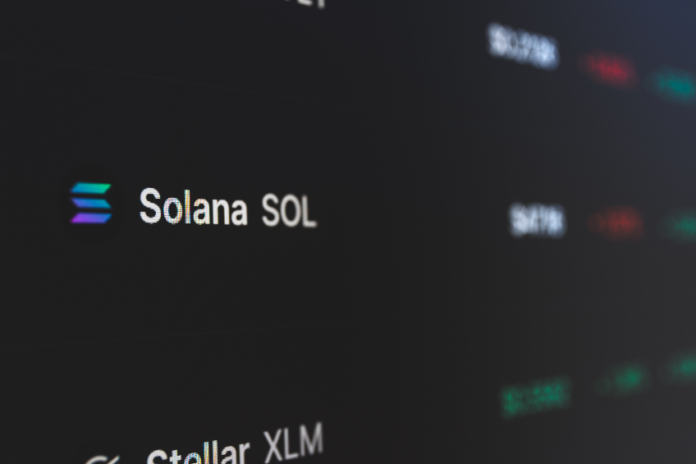Solana NFTs are catching up with Ethereum. Since mid-August, Solana’s NFT trading volume went up from 7% to 27%. According to Delphi Digital, as of September 4th, this means that the Solana’s NFT market share is closer than ever to Ethereum parity: 36% vs. 58%.
Given the total decline in NFT trading volume amid the bear market, Ethereum’s NFT market dominance fell by -27%, from the previous 85%. Moreover, enterprise-grade blockchains like Solana and Flow are the only ones, out of the top 5, to have increased monthly NFT trading volumes: +117% and +9% respectively.
Low Fees and Convenience Trump the First Mover Advantage
While Solana’s reputation has been somewhat eroded by multiple outages, it is still leagues ahead of Ethereum in terms of performance. Solana runs at 2,400 tps, while Ethereum runs at 14 tps on average.
More importantly, Solana has consistently low fees, which Ethereum can achieve only through the use of layer 2 scalability solutions. For instance, NFT minting on Ethereum typically costs around $10, while Solana NFT minting is under $0.02. Now that the Fed’s interest rate hikes punctured the NFT speculation bubble, such cost-saving measures are more important than ever.
With Solana fees so low, NFT transactions reached an all-time high of 389k following September 11th. Likewise, because the NFT market deflated and Ethereum had a head start, Solana NFTs are much cheaper. Case in point, DeGods is Solana’s highest valued collection at $11.4k floor price, which is not even within Ethereum’s top 5 collections.

Therefore, Solana’s top valued NFT collection is 876% cheaper than Ethereum’s top valued NFT collection. At the end of September’s first week, Solana NFT sellers peaked at 30k, always outnumbering buyers.

Lastly, according to Delphi Digital, Solana first-time buyers are up by +80%, with returning buyers up by +78% during September.
Join our Telegram group and never miss a breaking digital asset story.
Are Layer 2 Networks Too Cumbersome for Mass Adoption?
Bitcoin spearheaded the concept of sound money and digital assets. Ethereum spearheaded the concept of dApps, powered by more flexible smart contracts. For these reasons, BTC and ETH make up 57% of the total crypto market cap.
Among 149 smart contract chains, Ethereum holds 57.61% dominance, at 31.79 billion TVL. In contrast, Solana makes just 2.45% of this DeFi pie, at $1.35 billion TVL, according to DeFiLlama.

After the Merge, Ethereum is yet to lower its gas fees and increase its transaction throughput, which should arrive with the Surge upgrade sometime next year. In the meantime, Ethereum is dependent on layer 2 scalability solutions. For example, both Arbitrum One and Optimism have greater TVL than Solana.

With that said, the more extra steps are present in an ecosystem, the more they pose an obstacle to mass adoption. By necessity, layer 2 networks require bridges to transfer ETH funds from layer 1 to layer 2. In addition to inconvenience, this itself represents a vulnerability.
In contrast, layer 1 blockchains like Solana or Avalanche lack such obstacles, while already scaled up in terms of tps and negligible gas fees affordable for all. All things considered, Solana’s NFT uptick, compared to its minute DeFi share, could shape a trend.
Finance is changing.
Learn how, with Five Minute Finance.
A weekly newsletter that covers the big trends in FinTech and Decentralized Finance.
Do you think competitive chains will significantly shrink Ethereum’s market share by the next bull cycle? Let us know in the comments below.
About the author
Tim Fries is the cofounder of The Tokenist. He has a B. Sc. in Mechanical Engineering from the University of Michigan, and an MBA from the University of Chicago Booth School of Business. Tim served as a Senior Associate on the investment team at RW Baird’s US Private Equity division, and is also the co-founder of Protective Technologies Capital, an investment firm specializing in sensing, protection and control solutions.
Credit: Source link





















 Bitcoin
Bitcoin  Ethereum
Ethereum  Tether
Tether  Solana
Solana  USDC
USDC  Lido Staked Ether
Lido Staked Ether  XRP
XRP  Dogecoin
Dogecoin  Toncoin
Toncoin  Cardano
Cardano  Shiba Inu
Shiba Inu  Avalanche
Avalanche  Wrapped Bitcoin
Wrapped Bitcoin  TRON
TRON  Bitcoin Cash
Bitcoin Cash  Polkadot
Polkadot  Chainlink
Chainlink  Internet Computer
Internet Computer  Polygon
Polygon  Litecoin
Litecoin  NEAR Protocol
NEAR Protocol  Uniswap
Uniswap  LEO Token
LEO Token  Dai
Dai  Aptos
Aptos  Ethereum Classic
Ethereum Classic  Mantle
Mantle  First Digital USD
First Digital USD  Stacks
Stacks  Filecoin
Filecoin  Cronos
Cronos  OKB
OKB  Stellar
Stellar  Cosmos Hub
Cosmos Hub  Renzo Restaked ETH
Renzo Restaked ETH  Render
Render  Arbitrum
Arbitrum  Immutable
Immutable  Bittensor
Bittensor  Hedera
Hedera  dogwifhat
dogwifhat  Maker
Maker  Injective
Injective  The Graph
The Graph  Ethena USDe
Ethena USDe  Optimism
Optimism  Wrapped eETH
Wrapped eETH 
